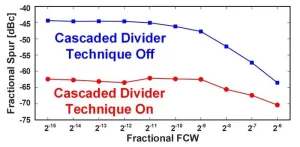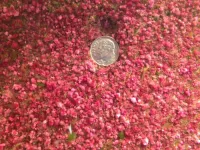(Press-News.org) Embargoed until 1:30 p.m. ET, Saturday Feb. 17, 2024
DENVER – Imageomics, a new field of science, has made stunning progress in the past year and is on the verge of major discoveries about life on Earth, according to one of the founders of the discipline.
Tanya Berger-Wolf, faculty director of the Translational Data Analytics Institute at The Ohio State University, outlined the state of imageomics in a presentation on Feb. 17, 2024, at the annual meeting of the American Association for the Advancement of Science.
“Imageomics is coming of age and is ready for its first major discoveries,” Berger-Wolf said in an interview before the meeting.
Imageomics is a new interdisciplinary scientific field focused on using machine learning tools to understand the biology of organisms, particularly biological traits, from images.
Those images can come from camera traps, satellites, drones – even the vacation photos that tourists take of animals like zebras and whales, said Berger-Wolf, who is director of the Imageomics Institute at Ohio State, funded by the National Science Foundation.
These images contain a wealth of information that scientists couldn’t properly analyze and use before the development of artificial intelligence and machine learning.
The field is new – the Imageomics Institute was just founded in 2021 – but big things are happening, Berger-Wolf told AAAS.
One major area of study that is coming to fruition involves how phenotypes – the observable traits of animals that can be seen in images – are related to their genome, the DNA sequence that produces these traits.
“We are on the cusp of understanding the direct connections of observable phenotype to genotype,” she said.
“We couldn’t do this without imageomics. It is pushing forward both artificial intelligence and biological science.”
Berger-Wolf cited new research on butterflies as one example of the advances that imageomics is making. She and colleagues are studying mimics – butterfly species whose appearance is similar to a different species. One reason for mimicry is to look like a species that predators, such as birds, avoid because their taste is not appealing.
In these cases, birds – as well as humans – can’t tell the species apart by looking at them, even though the butterflies themselves know the difference. However, machine learning can analyze images and learn the very subtle differences in color or other traits that differentiate the types of butterflies.
“We can’t tell them apart because these butterflies didn’t evolve these traits for our benefit. They evolved to signal to their own species and to their predators,” she said.
“The signal is there – we just can’t see it. Machine learning can allow us to learn what those differences are.”
But more than that, we can use the imageomics approach to change the images of the butterflies to see how extensive the mimics’ differences must be to fool birds. Researchers are planning to print realistic images of the butterflies with subtle differences to see which ones real birds respond to.
This is doing something new with AI that hasn’t been done before.
“We’re not using AI to just recapitulate what we know. We are using AI to generate new scientific hypotheses that are actually testable. It is exciting,” Berger-Wolf said.
Researchers are going even further with the imageomics approach to connect these subtle differences in how the butterflies look to the actual genes that lead to those differences.
“There’s a lot we are going to be learning in the next few years that will push imageomics forward into new areas that we can only imagine now,” she said.
One key goal is to use this new knowledge generated by imageomics to find ways to protect threatened species and the habitats where they live.
“There’s a lot of good that will come from imageomics in the coming years,” Berger-Wolf said.
Berger-Wolf’s AAAS presentation, titled “Imageomics: Images as the Source of Information About Life” is part of the session “Imageomics: Powering Machine Learning for Understanding Biological Traits.”
END
Imageomics poised to enable new understanding of life
Research on mimicry in butterflies provides one example
2024-02-17
ELSE PRESS RELEASES FROM THIS DATE:
Scientists try out stone age tools to understand how they were used
2024-02-17
Tokyo, Japan – Researchers from Tokyo Metropolitan University crafted replica stone age tools and used them for a range of tasks to see how different activities create traces on the edge. They found that a combination of macroscopic and microscopic traces can tell us how stone edges were used. Their criteria help separate tools used for wood-felling from other activities. Dated stone edges may be used to identify when timber use began for early humans.
For prehistoric humans, improvements in woodworking technology were revolutionary. While Paleolithic (early stone age) artifacts point to the use of wood for simple tools such as spears ...
Combating fractional spurs in phase locked loops to improve wireless system performance in Beyond 5G
2024-02-17
Two innovative design techniques lead to substantial improvements in performance in fractional-N phase locked loops (PLLs), report scientists from Tokyo Tech. The proposed methods are aimed to minimize unwanted signals known as fractional spurs, which typically plague PLLs used in many modern radar systems and wireless transceivers. These efforts could open doors to technological improvements in wireless communication, autonomous vehicles, surveillance, and tracking systems in beyond 5G era.
Many emerging and evolving technologies, such as self-driving vehicles, target tracking systems, and remote sensors, rely on the high-speed and error-free operation ...
20th Annual National Jewish Health Respiratory Disease Young Investigators’ Forum calls for abstracts
2024-02-17
DENVER — Young physician investigators interested in research careers in pulmonology, allergy and immunology, pediatric and related programs, are encouraged to submit basic science or clinical research abstracts by June 3, 2024, to be considered for participation in the 20th Annual Respiratory Disease Young Investigators’ Forum. This year’s Forum will take place October 17-20, 2024, in Denver.
The annual event provides career development and research opportunities for fellows and early career faculty. The Forum is a celebration of talent and ingenuity in respiratory medicine. Physician-scientists in fellowship ...
Study highlights importance of genetic sequencing to diagnosis of growth disorders
2024-02-16
In an article published in the Journal of Pediatrics, researchers based in Brazil describe the case of a nine-year-old boy admitted to hospital with multiple symptoms and overlapping conditions that made diagnosis difficult, such as short stature, thin tooth enamel (dental enamel hypoplasia), moderate mental deficiency, speech delay, asthma, mildly altered blood sugar, and a history of recurring infections in infancy.
The team used exome sequencing, in which only the protein-coding portion of the genome is analyzed, to look for genetic mutations, and found them in GCK and BCL11B. ...
Sylvester appoints prominent oncologist-researcher to lead transplantation and cellular therapy
2024-02-16
MIAMI, FLORIDA (Feb. 15, 2024) – Prominent oncologist and researcher Damian Green, M.D., will join Sylvester Comprehensive Cancer Center at the University Miami Miller School of Medicine this spring to lead its transplantation and cellular therapy services.
Green will serve as chief of Sylvester’s Division of Transplantation & Cellular Therapy, as well as assistant director of Translational Research, beginning March 1. He joins Sylvester from Fred Hutchinson Cancer Center in Seattle, where he built a distinguished track record in research and ...
Without social distancing, how do bacteria survive a viral epidemic?
2024-02-16
By Wynne Parry
WOODS HOLE, Mass. – Like humans struggling to get through the COVID-19 pandemic, bacterial cells need social distancing to thwart viruses. But in some situations, such as inside elevators or within the candy-colored bacterial structures known as “pink berries,” staying apart just isn’t feasible.
Looking like spilled Nerds or Pop Rocks, the communal, multicellular pink berries litter the submerged surface of salt marshes in and around Woods Hole. New research conducted at the Marine Biological ...
Commercial AI tool moderately successful at predicting hospitalization-related kidney injury
2024-02-16
Hospital-acquired acute kidney injury (HA-AKI) is a common complication in hospitalized patients that can lead to chronic kidney disease and is associated with longer hospital stays, higher health care costs and increased mortality. Given these negative consequences, preventing HA-AKI can improve hospitalized patient outcomes. However, anticipating HA-AKI onset is difficult due to a large number of contributing factors involved.
Researchers from Mass General Brigham Digital tested a commercial machine learning tool, the Epic Risk of HA-AKI predictive model, and found it was moderately successful at predicting risk of HA-AKI in recorded patient data. ...
JMIR Bioinformatics and Biotechnology has passed the Scientific Quality Review by NLM for PMC
2024-02-16
(Toronto, February 16, 2024) JMIR Publications is pleased to announce that JMIR Bioinformatics and Biotechnology has passed the Scientific Quality Review by the US National Library of Medicine (NLM) for PubMed Central (PMC). This decision reflects the scientific and editorial quality of the journal. All articles published from 2022 onward will be found on PMC and PubMed after their technical evaluation.
Launched in 2020, JMIR Bioinformatics and Biotechnology is a sister journal of Journal of Medical Internet Research ...
Modifying chemotherapy treatment can make life better for older adults with cancer
2024-02-16
Standard chemotherapy regimens, which are mostly based on testing in relatively young and healthy patients, may do more harm to older adults with cancer who often struggle with other health issues. New research, published yesterday in JAMA Network Open, shows that lowering the dose and adjusting the schedule of how chemotherapy is given to older adults with advanced cancer can make life better for patients, without compromising their treatment goals.
The study, which was led by researchers from the University of Rochester Medical Center’s Wilmot Cancer Institute, focuses on how well older people tolerate chemotherapy. More than 30 percent of patients benefitted from treatment regimen ...
Widely used machine learning models reproduce dataset bias in Rice study
2024-02-16
HOUSTON – (Feb. 16, 2024) – Rice University computer science researchers have found bias in widely used machine learning tools used for immunotherapy research.
Ph.D. students Anja Conev, Romanos Fasoulis and Sarah Hall-Swan, working with computer science faculty members Rodrigo Ferreira and Lydia Kavraki, reviewed publicly available peptide-HLA (pHLA) binding prediction data and found it to be skewed toward higher-income communities. Their paper examines the way that biased data input affects the algorithmic recommendations being ...
LAST 30 PRESS RELEASES:
Securing AI systems against growing cybersecurity threats
Longest observation of an active solar region
Why nail-biting, procrastination and other self-sabotaging behaviors are rooted in survival instincts
Regional variations in mechanical properties of porcine leptomeninges
Artificial empathy in therapy and healthcare: advancements in interpersonal interaction technologies
Why some brains switch gears more efficiently than others
UVA’s Jundong Li wins ICDM’S 2025 Tao Li Award for data mining, machine learning
UVA’s low-power, high-performance computer power player Mircea Stan earns National Academy of Inventors fellowship
Not playing by the rules: USU researcher explores filamentous algae dynamics in rivers
Do our body clocks influence our risk of dementia?
Anthropologists offer new evidence of bipedalism in long-debated fossil discovery
Safer receipt paper from wood
Dosage-sensitive genes suggest no whole-genome duplications in ancestral angiosperm
First ancient human herpesvirus genomes document their deep history with humans
Why Some Bacteria Survive Antibiotics and How to Stop Them - New study reveals that bacteria can survive antibiotic treatment through two fundamentally different “shutdown modes”
UCLA study links scar healing to dangerous placenta condition
CHANGE-seq-BE finds off-target changes in the genome from base editors
The Journal of Nuclear Medicine Ahead-of-Print Tip Sheet: January 2, 2026
Delayed or absent first dose of measles, mumps, and rubella vaccination
Trends in US preterm birth rates by household income and race and ethnicity
Study identifies potential biomarker linked to progression and brain inflammation in multiple sclerosis
Many mothers in Norway do not show up for postnatal check-ups
Researchers want to find out why quick clay is so unstable
Superradiant spins show teamwork at the quantum scale
Cleveland Clinic Research links tumor bacteria to immunotherapy resistance in head and neck cancer
First Editorial of 2026: Resisting AI slop
Joint ground- and space-based observations reveal Saturn-mass rogue planet
Inheritable genetic variant offers protection against blood cancer risk and progression
Pigs settled Pacific islands alongside early human voyagers
A Coral reef’s daily pulse reshapes microbes in surrounding waters
[Press-News.org] Imageomics poised to enable new understanding of lifeResearch on mimicry in butterflies provides one example



